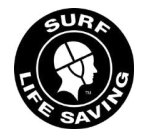(a) With a dive entry on an acoustic signal, the rescuer swims 50m freestyle with fins and rescue tube, where their patient is waiting with at least one hand on the turn wall or the starting blocks.
The patient may touch or grasp the rescue tube before the rescuer has touched the turn wall/edge but not release contact with the turn wall/edge or starting block until the rescuer has touched the turn wall/edge.
(b) As soon as the rescuer has touched the turning edge/wall of the pool, the patient can release contact with the turn edge/wall or starting block and the “clip in” of the patient into the rescue tube can commence.
(c) The rescuer and/or the patient secures the rescue tube around the patient’s body under both arms and clipped to an O-ring.
(d) This clip in must be completed within the 10m pick up zone (judged by the top of the patient’s head). The line of the rescue tube must be fully extended beyond the 10m line judged when the top of the head crosses the 10m line.
Note 1: Should the line of the rescue tube not be fully extended because of the power of the patient’s kick, the team shall not be disqualified.
Note 2: It is permitted for the rescuer and/or patient to push off from the turning wall.
(e) The patient must be towed on their back and the patient cannot be towed in any way other than the clipped into the rescue tube. The patient is permitted to assist by sculling under the surface of the water and kicking, but they must not swim with an out-of-water recovery.
Note: The patient repositioning their arms to a position in front of their head to streamline is not a disqualification.
(f) The finish is determined on the rescuer touching the edge/wall with one hand with the patient clipped into the rescue tube.
(g) Equipment:
- SLSA Approved Rescue Tube
- U13 age competitors and under must use rubber type fins as specified in this Section.
Note: Unless otherwise specified, competitors must use the Rescue Tubes supplied by the competition organisers.
(h) Event Conduct Notes:
- Starts with Rescue Tubes: The rescue tube and rescue tube line may be positioned at the Rescuer’s discretion, but within the team’s allotted lane. Competitors should ensure a safe and correct position of the rescue tube and line.
- Wearing Rescue Tubes: Rescue Tubes must be donned correctly, either with the loop over one or two shoulders, or over the shoulder and across the chest – at the competitor’s discretion. Assuming the rescue tube was donned correctly, there is no cause for disqualification if the loop falls down in the Rescuer’s shoulder or elbow during the rescuers’ approach or tow.
- Towing the Casualty: Rescuers must tow the patient in the tube towards the finish wall of the pool.
- Retrieving lost fins: Competitors may retrieve fins lost after the start and the team may continue in the race. The team will not be permitted to start again.
- Rescue tube defects: If in the referee’s opinion, the rescue tube, line or lanyard presents a technical defect during a race, the referee may allow the team to repeat the race.
(i) Disqualification In addition to the General Conditions for disqualification contained in the current SLSA Surf Sports Manual, the current edition ILS Competition Rule Book and any specific or amending competition Bulletins and Circulars the following behaviour shall also result in disqualification:
- (i) A false start as detailed in Section 2 – General Competitive Conditions.
- (ii) The patient releasing contact with the turn edge/wall or starting block before the rescuer has touched the edge/wall.
- (iii) Taking assistance from any pool fitting (e.g., lane rope, steps) when securing the rescue tube around the patient (except where the minimum pool depth allows the athlete to stand).
- (iv) The rescue tube not being secured around the patient (judged at the top of the patient’s head) before passing the 10m line.
- (v) The patient becoming detached from the rescue tube (other than a technical defect with the tube – see tube defect note) after passing the 10m line and prior to the rescuer touching the finishing edge/wall.
- (vi) The patient not being towed on their back and clipped into the rescue tube and behind the rescuer.
- (vii) The patient’s arms breaking the water to assist the tow with an out-of-water arm recovery.
- (viii) The Patient touching the finishing edge/wall before the rescuer.
- (ix) The Rescuer not touching the finish edge/wall.

